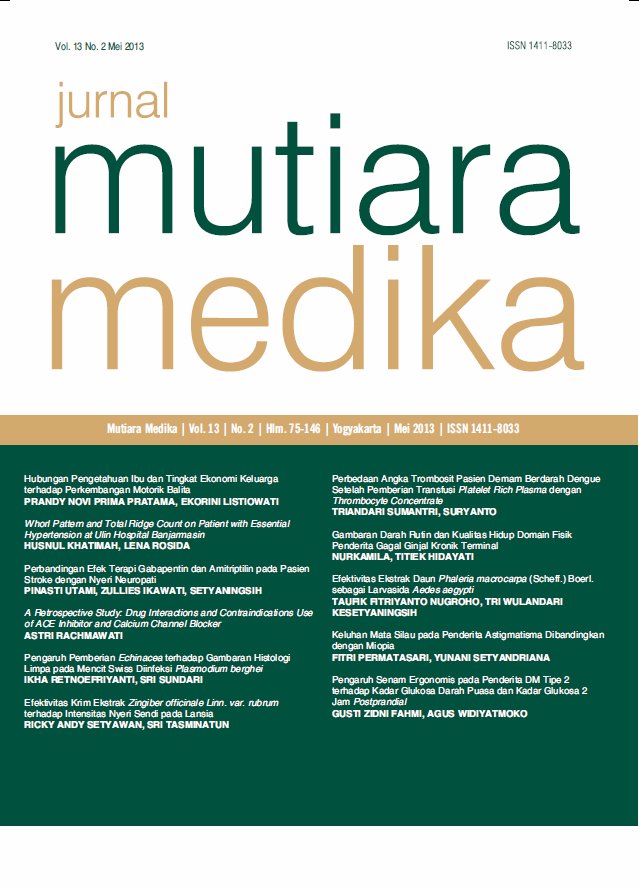Whorl Pattern and Total Ridge Count on Patient with Essential Hypertension at Ulin Hospital Banjarmasin
DOI:
https://doi.org/10.18196/mmjkk.v13i2.1058Keywords:
whorl, essential hypertension, ridge skinAbstract
Dermatoglypics can used to predicted a disease such as essential hypertension. The aim of this research is to know of summary of whorl pattern and total ridge count on patient with essential hypertension in department of internal medicine of Ulin hospital Banjarmasin period Juli – August 2007. Sample of research from patient with essential hypertension that diagnosed by doctor in department of internal medicine of Ulin hospital Banjarmasin (32 samples), control samples are from normotension person (32 samples). The variables that observed are summary of whorl pattern and total ridge count. The result show that patient with essential hypertension with whorl pattern > 6 is 81,25 %, normotension is 25%. Summary of average of total ridge count in patient with essential hypertension is 147,38, normotension is 129,38. It can be concluded there is difference from patient with whorl pattern > 6 and total ridge count between essential hypertension with control (p<0,05).
Dermatoglifi dapat digunakan untuk memprediksi penyakit seperti hipertensi esensial. Tujuan penelitian ini adalah untuk mengetahui pola sidik jari whorl dan total jumlah rigi sidik jari pada pasien dengan hipertensi esensial di bagian penyakit dalam rumah sakit Ulin Banjarmasin periode Juli – Agustus 2007. Sampel penelitian adalah pasien dengan hipertensi esensial yang didiagnosis oleh dokter di bagian penyaki dalam rumah sakit Ulin Banjarmasin sebanyak 32 sampel, kontrol dari pasien dengan normotensi sebanyak 32. Variabel penelitian adalah pola sidik jari whorl dan total jumlah rigi sidik jari. Hasil penelitian menunjukkan bahwa pasien hipertensi esensial dengan pola whorl > 6 adalah 81,25%, normotensi adalah 25%. Rata-rata jumlah rigi sidik jari pada pasien dengan hipertensi esensial adalah 147,38, normotension adalah 129,38. Disimpulkan bahwa ada perbedaan dari pasien dengan pola whorl > 6 dan total jumlah rigi sidik jari antara hipertensi esensial dengan kontrol (p <0,05).
References
Najafi, M. Association between Finger Patterns of Digit II and Intelligence Quotient Level in Adolescents. Iran J Pediatr, 2009; 19 (3):277-284
Sharma, MK., Jahwar P., Sharma, H., Sharma, S. & Kalavatia, I. Dermatoglyphics an Attempt to Predict Downs Syndrome. Int J Biol Med Res. 2012; 3 (2): 1631-1635.
Raden I. Pola Dermatoglifi pada Ujung Jari dan Tapak Tangan Penderita Hipertensi Esensial Orang Dewasa Indonesia. Maj Kedok Yarsi, 2006; 14 (1): 005-010
Maolian G and Norbert H. Molecular Genetics of Human Hypertension. Clinical Science, 2006 ; 110 (3): 315–326.
Daniela P, Kuklik M, Berankova M, Schaumann. Dermatoglyphics in Juvenile Hypertension. J Biol. 1991; 49 (4): 361-366.
Ramelan W. Perkembangan Genetika Manusia dalam Hubungan dengan Reproduksi. MKI, 1999; 49 (6): 228-239
Sufitni. Perbandingan Garis Simian dan Pola Sidik Jari pada Kelompok Retardasi Mental dan Kelompok Normal. Tesis. Fakultas Kedokteran, Universitas Sumatera Utara, MKI 2007; 4: 3
Edward DC. Fingerprint & Palmar Dermatoglypics, (http://www.pdc.co.il diakses 1 april 2007).
Schaumann B. Alter M. Dermatoglyphic in Medical Disorders. New York: Springer-Verlag, 1976.
Rajangam, S., Ravindranth, R., Shubha, R., Nagesh, H.V. & Johnson, J. DermatoglyphicsQuantitative Analysis in Rheumatoid Arthritis. Anthropologist. 2008; 10 (3): 233-235.
Downloads
Published
Issue
Section
License
Copyright
Authors retain copyright and grant Mutiara Medika: Jurnal Kedokteran dan Kesehatan (MMJKK) the right of first publication with the work simultaneously licensed under an Attribution 4.0 International (CC BY 4.0) that allows others to remix, adapt and build upon the work with an acknowledgment of the work's authorship and of the initial publication in Mutiara Medika: Jurnal Kedokteran dan Kesehatan (MMJKK).
Authors are permitted to copy and redistribute the journal's published version of the work (e.g., post it to an institutional repository or publish it in a book), with an acknowledgment of its initial publication in Mutiara Medika: Jurnal Kedokteran dan Kesehatan (MMJKK).
License
Articles published in the Mutiara Medika: Jurnal Kedokteran dan Kesehatan (MMJKK) are licensed under an Attribution 4.0 International (CC BY 4.0) license. You are free to:
- Share — copy and redistribute the material in any medium or format.
- Adapt — remix, transform, and build upon the material for any purpose, even commercially.
This license is acceptable for Free Cultural Works. The licensor cannot revoke these freedoms as long as you follow the license terms. Under the following terms:
Attribution — You must give appropriate credit, provide a link to the license, and indicate if changes were made. You may do so in any reasonable manner, but not in any way that suggests the licensor endorses you or your use.
- No additional restrictions — You may not apply legal terms or technological measures that legally restrict others from doing anything the license permits.






